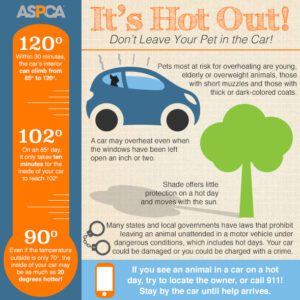Long summer days mean lots of outdoor activities, often with our pets. It also means its time to watch for signs of heat stroke. The combined heat and humidity of a Virginia summer is particularly dangerous for pets. Dogs and cats have to pant to cool their body, which is not as efficient as sweating and places pets at a higher risk for heat stroke, particularly when external temperatures are not much cooler than your pet’s body temperature.
Heat stroke is deadly, with studies showing an overall mortality rate of 50 percent. Fast action is crucial for the best chance of survival. Awareness and recognition of the signs of heat stroke, immediate application of effective cooling methods, and veterinary intervention within 90 minutes can all lead to a higher possibility of full recovery.
Symptoms of Heat Stroke in Pets
- Panting, drooling, dehydration
- Red gums and moist tissues
- Rapid and/or irregular heart rate
- Breathing distress
- Body temperature above 103°F for dogs, 105°F for cats
- Bloody vomiting and stools, and low or no urine production
- Lethargy – although cats often start out restless looking for a cool place to lay
- Stumbling and discoordination
- Seizures and changes in mental status
- Cardiopulmonary arrest (heart and breathing stops)
- Unconsciousness
Tips for Preventing Overheating, Heat Exhaustion, and Heat Stroke
- Always provide access to plenty of water and shade. Keeping pets wet can help keep body temperature down.
- NEVER leave a pet in a parked car – not even in the shade, not even for a short amount of time.
- Even working dogs acclimatized to the conditions can develop heat stroke quickly.
- Restrict exercise, especially for sedentary and at-risk animals. Walk in the early morning or late evening when it is cooler.
- Avoid places with a lot of reflected heat and no shade– think asphalt, concrete, and beaches.
- Know that risk factors such as obesity, old age, heart conditions, brachycephalic breeds (squishy faces), or breathing problems can cause heat exhaustion with even normal activities.
- Make sure your pets have access to the coolest area of your house. Ice in sealed baggies or water frozen in plastic bottles can be wrapped in cloth and placed on the floor in case of air conditioning failure.
Pet First Aid for Heat Stroke
Gradual cooling and veterinary intervention within 90 minutes of onset are crucial for recovery from heat stroke. Contact your primary care veterinarian as soon as possible if you think your pet is suffering from heat stroke.
Safe and Effective Cooling Methods
- Place your pet on a cool surface, ventilated if possible
- Continually pour cool (NOT cold) water over your pet
- Use a fan to provide air flow to carry heat away
- STOP cooling at 103.5°F
- Seek medical attention immediately
Your veterinarian will likely provide IV fluids, pain management, and antibiotics, as well as perform lab work, EKG monitoring, and care for any secondary injury. Your pet will need good nursing care with frequent monitoring to catch any changes early for fast intervention.
We hope you find these tips helpful as you start to enjoy the long, warm summer days with your furry friends.
Remember, The COVE veterinarians are here for you 24/7/365 or can be reached at 757-935-9111 if your pet needs emergency attention.
About Us
The COVE’s veterinarians and staff wholeheartedly embrace the core values of community, collaboration, commitment, compassion, and integrity. This focus ensures that pets, the people who love them, and their primary care veterinarians have as positive and affirming a healthcare experience as possible, regardless of the circumstances that bring us all together.

